The Vishera Review: AMD FX-8350, FX-8320, FX-6300 and FX-4300 Tested
by Anand Lal Shimpi on October 23, 2012 12:00 AM ESTProjected Performance: Can AMD Catch up with Intel?
I keep going back to this slide because it's incredibly relevant. It's the only indication we have from AMD of what its future roadmap will look like in terms of performance increases:
Each year AMD promised to increase performance of its high-end cores by roughly 10 - 15%. Astute observers will note that, at this rate, AMD will almost never catch up to Intel. AMD at the time was careful to point out that it's talking about 10 - 15% gains in core performance, and it could potentially see even larger increases in total chip performance by pulling other levers. Vishera is an example of AMD doing just that. The Piledriver cores by themselves don't increase performance tremendously, but they do give AMD a little more thermal headroom to work with thanks to some more efficient design decisions and better transistor choice. With Vishera, AMD took the additional power headroom and turned into a frequency advantage. The result is AMD's FX-8350 can operate in the same power envelope as the outgoing FX-8150, yet runs at an 11% higher base clock (turbo frequency remains the same). Through frequency and core level improvements, AMD was able to deliver a bit more than the 10 - 15% performance increased in promised.
If AMD is able to repeat these improvements again next year, I wondered whether or not it would get any closer to closing the gap with Intel - particularly when it came to single threaded performance. We already know from our Haswell investigations that Intel is expecting around a 5 - 15% increase in CPU performance from Haswell over Ivy Bridge. If we assume that Haswell delivers towards the 15% end of that spectrum, and if we assume that Steamroller delivers the same level of improvements that we saw from Piledriver/Vishera, we end up with some pretty interesting predictions for where things end up next year. I modeled the 2013 performance of high-end AMD and Intel platforms based on those two factors and plotted the curves in a few different benchmarks. For each generation I used the parts that AMD stacked up against one another (they are also fairly similarly priced). For 2011 I used the FX-8150 vs. Intel's Core i5 2500 and for 2012 I used the FX-8350 vs. Intel's Core i5 3570. The 2013 data is of course projected based on a 15% increase in performance from Haswell, and a repeat of the Vishera vs. Zambezi increase for AMD. This is mostly an interesting experiment so don't get too invested in the data.
We'll start with Cinebench, by far the most painful of the tests for AMD from a single-threaded performance perspective:
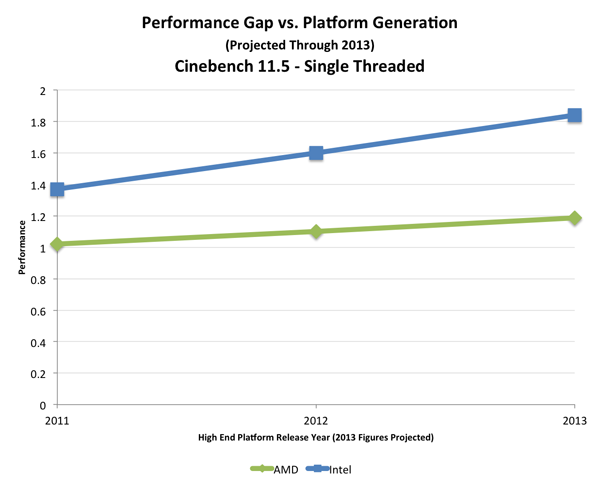
The Vishera gains here were decent but not enough to dramatically shrink the performance gap. Furthermore, Intel put a good amount of distance in place with Ivy Bridge and if it can continue that with Haswell I don't see much hope here.
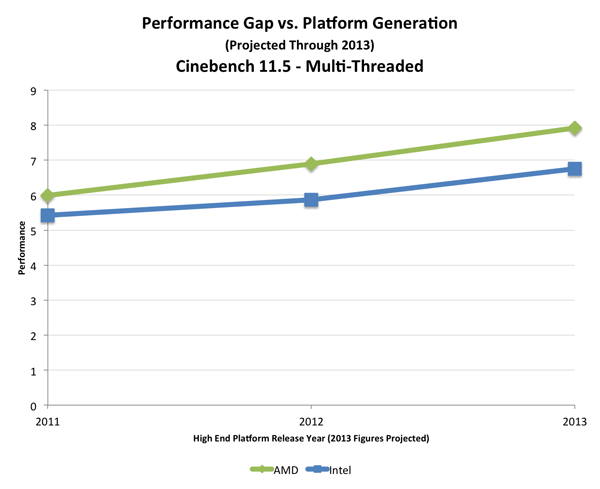
The multithreaded Cinebench results begin in AMD's favor and remain so even with our projected performance data.
Mozilla's Kraken benchmark is another example of single threaded performance gone awry for AMD.
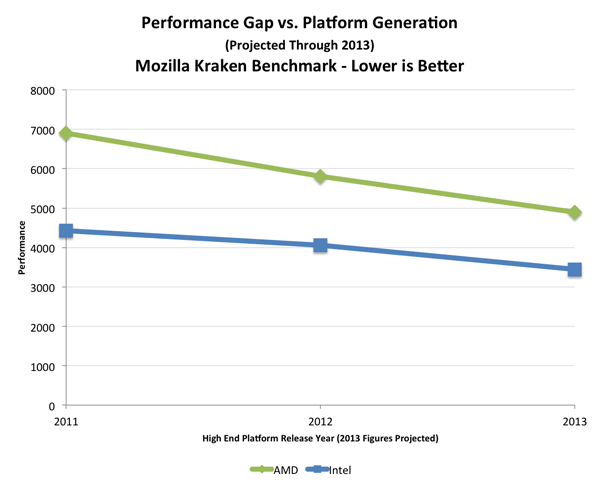
Thankfully, Vishera does close the gap by a decent amount and if AMD extends those gains it is on an intercept course with Intel. The bad news is, that intercept wouldn't be in 2013.
POV-Ray provides another point of view on single threaded performance, here the situation looks far less dire than under Cinebench:
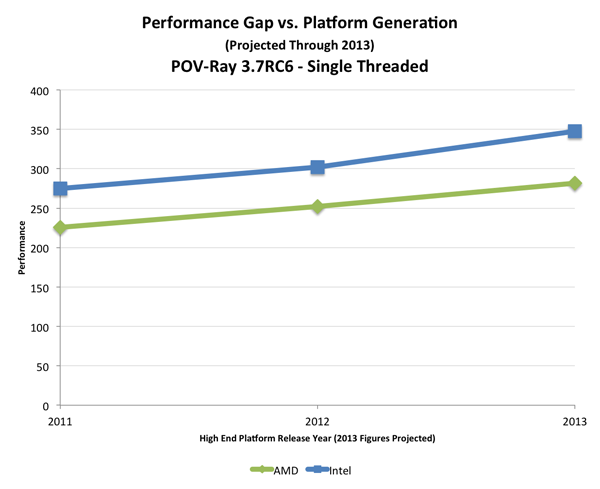
Unfortunately the curves remain fairly distinct.
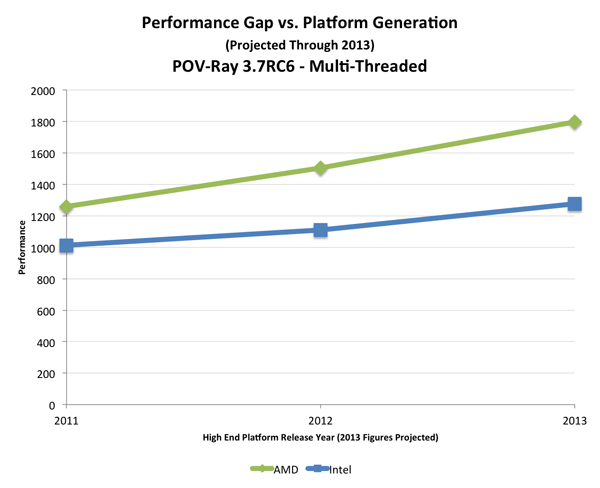
Once again, when we increase thread count we see AMD pull ahead.
SYSMark is a particularly telling benchmark as it is lightly threaded and does a good job of simulating all types of workloads:
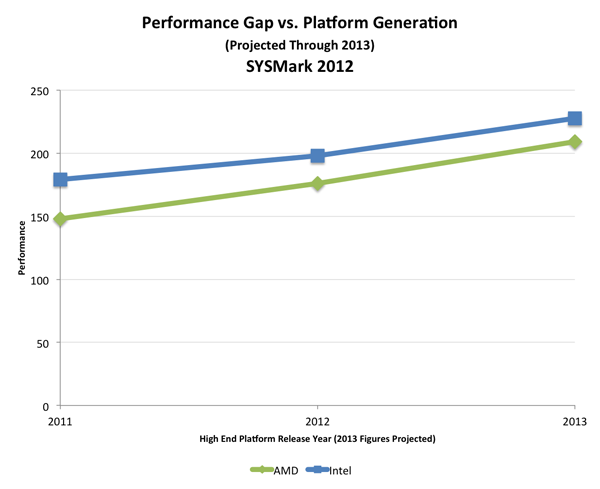
The result here is AMD closing in, albeit slowly, on Intel's performance advantage. I suspect this is quite possibly the best case scenario for AMD, it doesn't necessarily want to surpass Intel in performance but it wants to get close enough where pricing and other factors (e.g. GPU performance in its APU parts) can make a bigger difference.
Our Visual Studio 2012 test is a good combination of single threaded and multithreaded workloads in one:
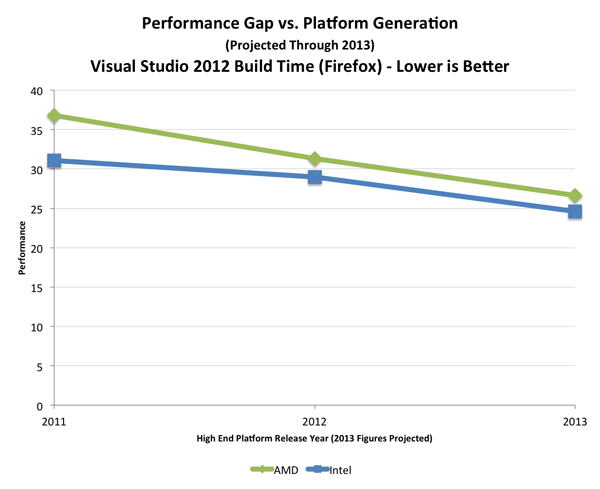
With Vishera, AMD did a lot to close the gap betwen itself and Intel. Another increase like this and we won't see AMD surpass Intel, but the two should remain fairly close.
These last two tests show us the other side of the coin. If both AMD and Intel continue on their present tracks, what will happen in a test where AMD already does well today?
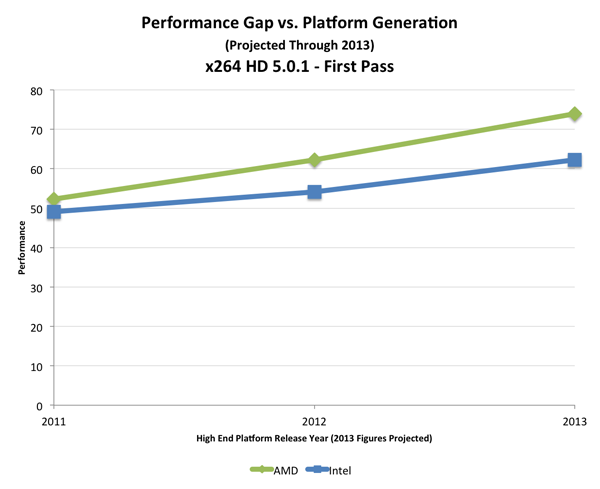
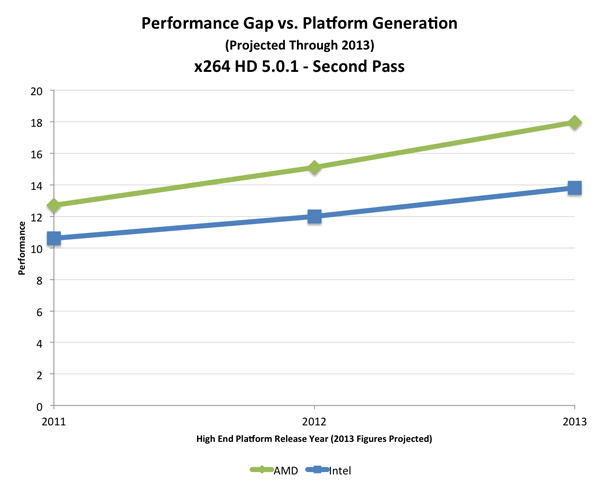
In areas where AMD holds a significant advantage, Haswell would need to deliver more than a 15% gain in performance at the same price point to catch up.
None of the results here are all that surprising. AMD remaining on its current course isn't enough to dramatically change its standings vs. Intel in another year. Vishera definitely cut into the performance delta, but the 2013 follow-up will have to do even more to really have an impact. Steamroller is far more focused on increasing IPC, however without a new process node it'll be difficult to demonstrate another gain in frequency like we see today with Vishera. I suspect the real chance for AMD to approach parity in many of these workloads will be with its 20nm architecture, perhaps based on Excavator in 2014.











250 Comments
View All Comments
A5 - Tuesday, October 23, 2012 - link
The gaming benchmarks contain exactly 0 FPS games. You should really read the article before commenting.kevith - Tuesday, October 23, 2012 - link
I could eat a dictionary and SHIT a better comment than that.CeriseCogburn - Tuesday, October 30, 2012 - link
" The FX-8350 did immensely better in that gaming selection. Mostl gamers are not shoot-em-up fascist gamers. "LOL - wrong again, but your lefty whine was extremely amusing. Most gamers are shoot em up gamers, YOU LIAR.
GullLars - Tuesday, October 23, 2012 - link
What they didn't show you is what happens when you OC the K parts from intel. They end up roughly in the same TDP as AMD on stock, and just crush them on performance, so if you are going to use the same aftermarket cooler and will overclock either pick, the Intel parts can go further and win across the board.Compared to the cost of an entire system ~$100-150 extra on the CPU for a 3770K might end up being around a 10% increase in total build cost, and giving you anywhere from 10 to 50% better performance (or more in some corner cases).
I'm happy with my OC'd 3930K :D (compared to to the rest of my equipment, the price was no problem)
Probably upgrading my C2D 2.0GHz + 8600GTM laptop to a Haswell with only IGP in 2013. With an SSD and RAM upgrade it has had surprisingly good longevity.
CeriseCogburn - Tuesday, October 30, 2012 - link
Exactly, all the amd cpu unlockers, all the dang phenom 2 overlcockers - totally silent.The 2500K smoke sit up to 4500mhz like butter, but heck, when something is freaking GREAT and it's not in amd's advantage, it's memory hole time, it's ignore it completely after barely mentioning it, and just as often continue to declare it an unused and unliked and proprietary failure that holds everyone back - whatever can be done to lie and skew and spin.
It's just amazing isn't it.
eanazag - Tuesday, October 23, 2012 - link
I had pretty low expectations admittedly and for good reason. This is a great step because I would have to think platform vs. platform where before I didn't even need to consider it. Intel has a huge thermal advantage, which indicates that Intel could easily come out with a proc at anytime to take advantage of that headroom should AMD ever become slightly threatening, and sadly still be below performance per Watt. I could reasonably consider AMD now for my desktop. Where AMD fails is at the platform level. They have underperformed in the motherboard department. If they wanted to sell more, they need to give serious advantages at the motherboard + CPU purchase level versus Intel. They have been fine with a mediocre chipset. They failed when they locked out Nvidia from chipset development, same with Intel. AMD and Intel's greed was a big loss for the consumer and part of the reason why AMD doesn't compete well with Intel. Nvidia made better chipsets for AMD than AMDs ATI chipset development team.It is even worse on the server side for AMD. AMD needs to include 10GbE on the board to really question Intel and this is doable. AMD cannot compete on process (22nm and 3D transistors) unless Intel closed shop for 18 months.
CeriseCogburn - Tuesday, October 30, 2012 - link
LOL - thank you so much.Yes, the hatred for nVidia (and Intel) cost the amd fanboys dearly, but they really, really, really enjoyed it when nVidia chipsets got shut down.
nVidia was going to be destroyed then shortly thereafter according to them, and thus we heard a couple years of it from their freaking pieholes - amd would drop the price and knife nVidia into oblivion... and bankrupcty... cause amd has a "lot more room" to price drop and still rake in profit... they said... LOL - as they whined about nVidia being greedy and making so much money.
Yes, they were, and are, nutso.
Oh the party days they had... now they have CRAP. LOL
Ken g6 - Tuesday, October 23, 2012 - link
Anand, I think you missed a diamond in the rough here for gaming. Obviously, if someone has the money for an i5, they should get an i5. But if they don't, the FX-4300 looks like a better gaming choice than an i3. There are cheap mobos available, so overall cost is less than an i3, and the FX-4300 is overclockable. OCed it may even approach low-end i5 performance - at a power cost, of course.tekphnx - Tuesday, October 23, 2012 - link
For only $10 more I'd say the FX-6300 is the better bet. Slightly lower clock speed but still overclockable, and I don't think it will be that long before six cores become really relevant for gaming.lmcd - Tuesday, October 23, 2012 - link
Worst case you can probably disable a core and OC more, right?